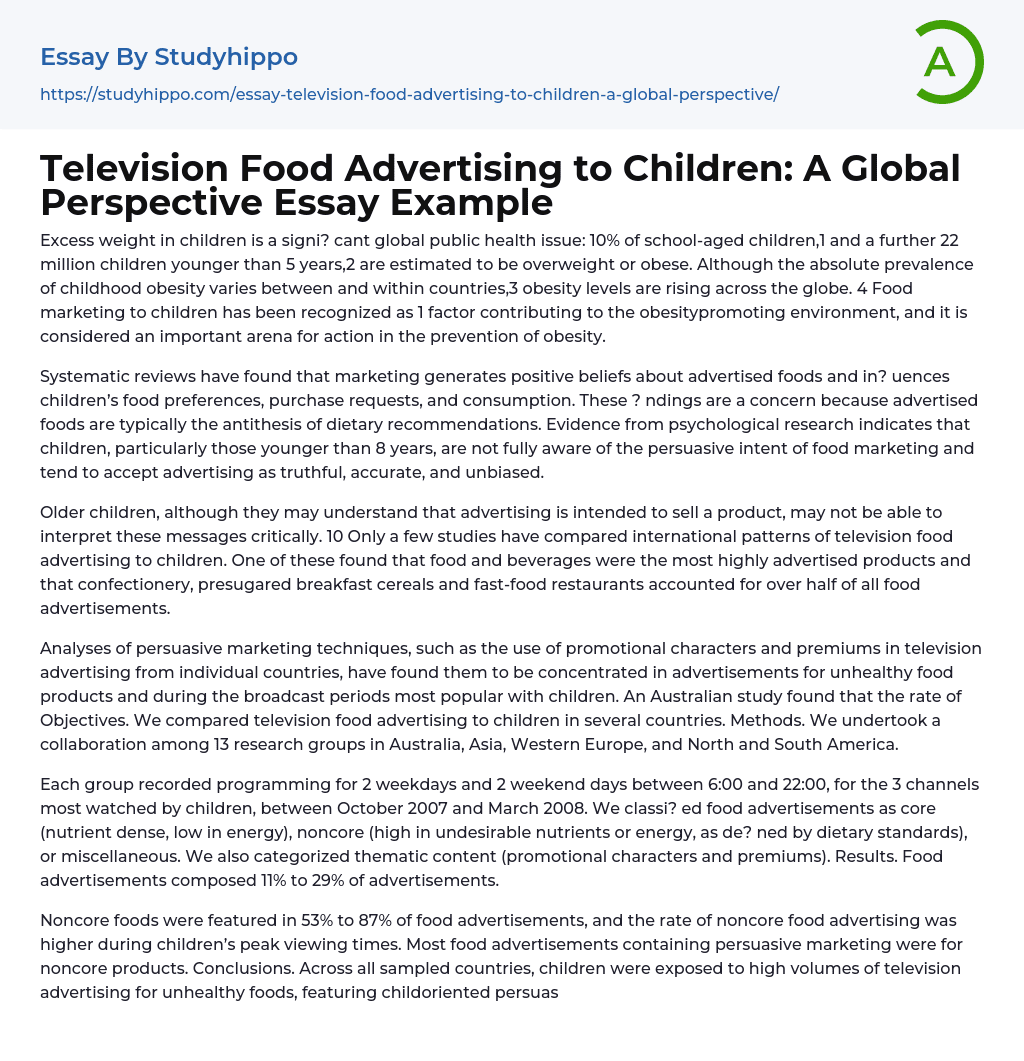

Television Food Advertising to Children: A Global Perspective Essay Example
Childhood overweight and obesity is a major public health problem worldwide. Approximately 10% of school-aged children and an additional 22 million children under the age of 5 are classified as overweight or obese. The prevalence of childhood obesity varies both across countries and within them, but its global incidence is on the rise. An important factor contributing to this issue is the marketing of food targeted towards children, which plays a significant role in creating an obesogenic environment. Consequently, addressing this aspect becomes crucial for preventing and intervening in this condition.
Studies have revealed that marketing has a favorable influence on children's attitudes towards advertised foods, affecting their preferences, requests to buy, and consumption. This is worrisome as these foods often do not correspond with dietary guidelines. Psychological research indicates that young children, especially those below 8 y
...ears old, are not completely aware of the persuasive nature of food marketing and tend to view it as honest, precise, and impartial.
While older children recognize that advertising has the goal of promoting a product, they may face difficulties in critically analyzing its messages. Although there is limited research on global television commercials aimed at children, one study found that food and beverages were the most commonly advertised products. Moreover, more than half of all food advertisements showcased confectionery items, pre-sweetened breakfast cereals, and fast-food restaurants.
Analyses of persuasive marketing techniques, such as the use of promotional characters and premiums, in television advertising from various countries have revealed a concentrated presence in advertisements for unhealthy food products. Additionally, these techniques are predominantly utilized during the broadcast periods that are most favored by
children. A study conducted in Australia compared television food advertising to children in multiple countries and involved collaboration among 13 research groups from Australia, Asia, Western Europe, and North and South America.
Between October 2007 and March 2008, each group documented programming for 2 weekdays and 2 weekend days between 6:00 and 22:00. This data was collected for the 3 channels most frequently watched by children. In our classification, food advertisements were categorized as core (nutrient dense, low in energy), noncore (high in undesirable nutrients or energy, as defined by dietary standards), or miscellaneous. Additionally, we analyzed thematic content such as promotional characters and premiums. Our findings revealed that food advertisements constituted 11% to 29% of all advertisements.
Between 53% and 87% of food advertisements showcased noncore foods, and the frequency of noncore food advertising was particularly elevated during children's prime viewing hours. The majority of food advertisements utilizing persuasive marketing techniques were for noncore items. As a result, our study supports the need for regulations on food advertising during peak children's viewing periods due to the established link between food advertising, preferences, and consumption.
During the most popular children’s programs, the rate of unhealthy food advertisements with premiums was 18 times higher compared to adults’ popular programs. Additionally, the rate of advertisements with promotional characters was twice as high. We conducted a study to compare and analyze television food advertising targeted at children across different countries, including assessing the frequency and nature of these advertisements. We also examined food advertising during peak viewing periods for children and evaluated the use of persuasive marketing techniques.
- Sales Promotion essays
- Advertising campaign essays
- Food Safety essays
- Food Security essays
- Beverages essays
- Cuisines essays
- Dairy essays
- Desserts essays
- Fast Food essays
- Bread essays
- Meal essays
- Meat essays
- Organic Food essays
- Rice essays
- Sugar essays
- Taste essays
- Beef essays
- Coconut essays
- Crowd essays
- Dinner essays
- Juice essays
- Sainsbury essays
- Cooking essays
- Ginger essays
- Oreo essays
- Drink essays
- Beer essays
- Wine essays
- Coffee essays
- Tea essays
- Cake essays
- Hamburger essays
- Ice Cream essays
- Burger essays
- Pizza essays
- Fruit essays
- Lemon essays
- Food Waste essays
- Favorite Food essays
- Alcoholic essays
- Soft Drinks essays
- Cookie essays
- Starch essays
- Yeast essays
- Cola essays
- Pizza Hut essays
- snack foods essays
- chips essays
- Biscuit essays
- Brewing essays



